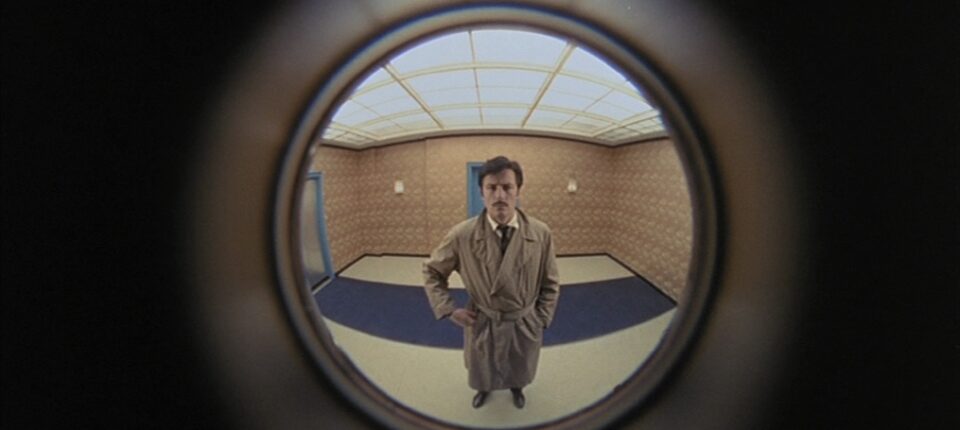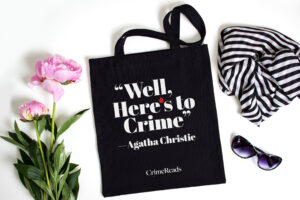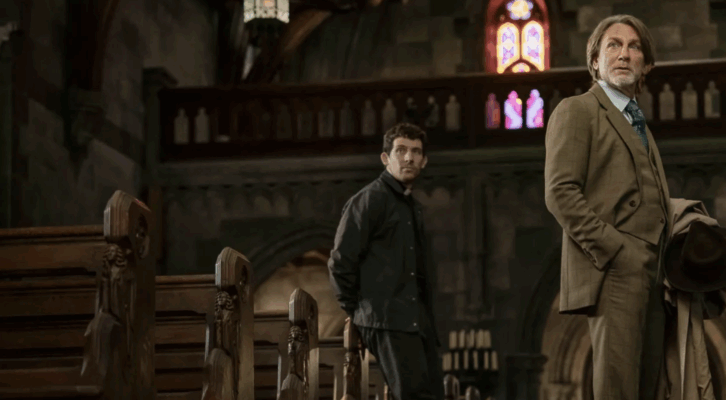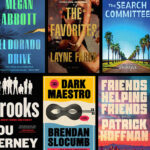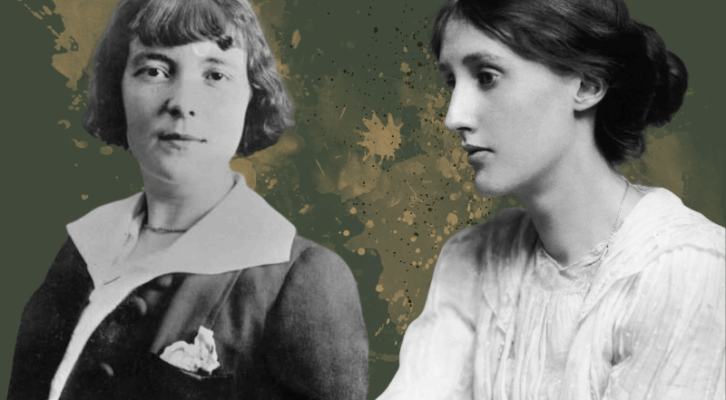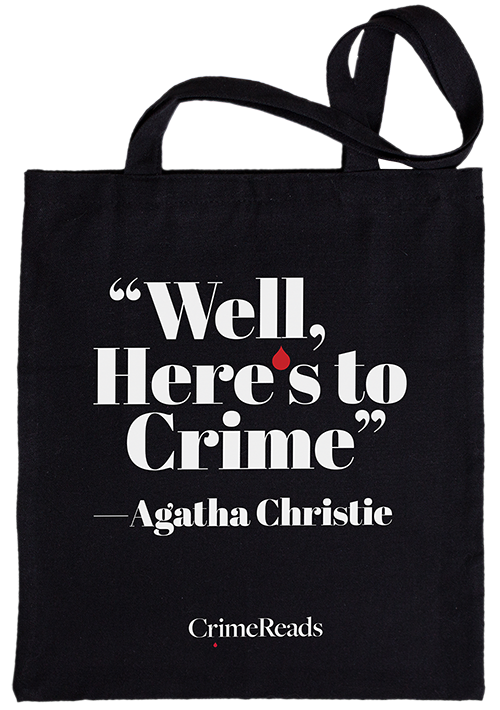Last month’s daring jewel heist at the Louvre museum, which captivated the world, seems to be reaching its dénouement. Two of the perpetrators of the escapade –a daylight smash-and-grab that nabbed $100 million of Napoleonic crown jewels in about 4 minutes–-have been captured, and the police hope for more arrests. While the jewels remain at large, it seems like this glorious distraction of a story may be over for now, and we’ll have to settle back into the relentlessly grim news cycle.
But do not despair–reprends courage! There’s plenty of great jewel robberies to be found in the French cinema. The French love dark and daring crime stories, and they’ve put many great jewel robberies on the screen. In the golden age of heist movies, acclaimed directors like Jean-Pierre Melville made fabulous jewels the loot in their perfectly crafted crime flicks. But great directors of other eras and genres have gone deeper, pondering what the act of stealing expensive and beautiful things reveals about class, morality, and intimacy. They produced more sentimental and comic variations on the theme. The past two decades have seen some interesting revisions on the genre, playing with light and dark and embracing its wild and daring heart. Each film, in its own way, has that je ne sais quoi that makes the jewel robbery film a perfect piece of pop culture escapism
Here, for your viewing pleasure, are France’s greatest jewel robbery movies.
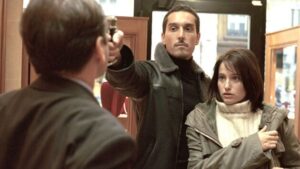
9. Not For, Or Against (Ni pour, ni contre (bien au contraire), (2003)
Cédric Klapisch, best known for the comedy L’Auberge Espagnole surprised the film world with this stylish, compelling, uneven crime drama. A television camerawoman, Caty (Marie Gillain), tumbles into the underworld when she meet the alluring thief Jean (a very charming Vincent Elba. Of course, she tells herself that she’s only documenting a heist, but it’s not long before she’s a genuine criminal revelling in a life of easy cash and illicit thrills. Its comic opening section introduces the crew (featuring the warm, disheveled Zinedine Soualem and a brooding Simon Abkarian). But we’re soon plunged into darker terrain. These contrasts are jarring, yet Klapisch’s aesthetic (inspired by French crime films of yore) keeps drawing you in. The climactic robbery is authentically supenseful, and the morally ambiguous resolution is unexpectedly bold.
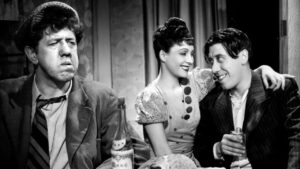
8. Fric-Frac (1939)
The cheeriest film on the list, Fric-Frac turns the heist film into a witty comedy about love and class. While it doesn’t have lingering shots of glittering diamonds or scenes of clever plotting, it does boast three of the finest actors of 1930s French cinema: Fernandel, Arletty, and Michel Simon. Marcel (Fernandel) plays a dopey clerk at a jewelry store. He’s awed by the fast, slang-talking friends he makes at a velodrome, and too naive to realize that they are members of the criminal underclass. Arletty’s gangster’s moll has a sly warmth beneath her calculating exterior. Simon, rough-hewn and jolly in his amorality, is always on the lookout for a petty con that will pay for the next round. The pair strings Marcel along good-naturedly, until a sudden need for cash means they’ll need him to help rob his store. Jewel robbery movies, in their comic mode, always involve the meeting of different social classes and the conflicts that arise when the criminals and the victims actually grow to like each other. Bringing this to the fore with a light touch and a leisurely pace, director Claude Autant-Lara makes this tale of the ties between thieves and their marks into a sharp comedy with a tender heart.

7. The Last Diamond (Le Dernier Diamant), (2014)
A pleasing entry in the “let’s steal an enormous, very famous diamond” subgenre. The planning and execution of the heist are a bit old hat, but there are some satisfying dramatic twists. Everything rests on Yvan Attal’s portrayal of Simon, who’s somewhere between a petty ex-con and a suave gentleman thief. This is a classic con-mark romance story, and the chemistry between Attal and Bérénice Bejo’s vulnerable Julia is a good slow burn. This works with Last Diamond’s dramatic pacing, as the final third takes a dark and tragic turn. The plot twists reflect the reality that the underground diamond trade involves dealing with some really scary, really corrupt dudes. The tonal shifts feel a bit incongruous, but it wraps up nicely.
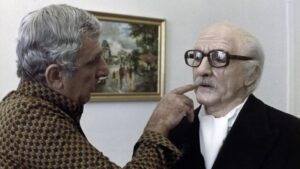
6. Happy New Year (La bonne année), (1973)
Claude Lelouch–most famous for his lush romance A Man and a Woman (Une homme et une femme, 1966) uses the heist film as an occasion for another complicated adult romance. Thief Simon (Lino Ventura, just settling into cragginess) and the haute bourgeoise shop owner Françoise (Françoise Fabian) know they come from different worlds. Still, they embrace the erotic charge of their differences in a series of frank but playful encounters. The screen crackles when they’re together, but that doesn’t mean Lelouch skimps on the heist plot. Simon has equally sparkling chemistry with his amiable accomplice Charlot (Charles Gérard), and there’s good fun to be had as they spend days casing a Van Cleef and Arpels shop in Cannes, donning rubbery prosthetics and disguises as part of their elaborate ruse. A mix of color and black-and-white footage and jumps in time add to the ingenuity and beauty of a legitimately romantic, legitimately fun heist tale.
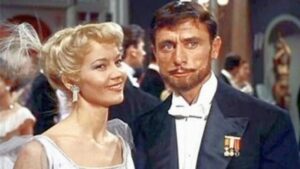
5. The Adventures of Arsène Lupin (Les aventures d’Arsène Lupin), (1957)
If the current Netflix series is the perfect contemporary adaptation of Maurice Leblanc’s immortal gentleman thief, Jacques Becker perfectly recreates the original in this glorious confection.
The Belle Époque comes to life in gleaming color, with artful décor, slim silhouettes, and fabulous hats. As Lupin, the feline Robert Lamoureux is effortlessly elegant and always unflappable. The master criminal is never in any real danger. (It’s rare for a robbery film to show so much of a thief performing his toilette.) The pleasure comes from watching him, sometimes literally, waltz through his robberies (including nabbing a nice little diamond parure) with graceful mastery. This is sheer delight from beginning to end.
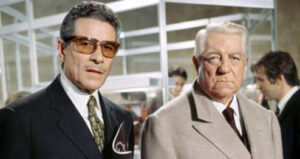
4. The Sicilian Clan (Le clan des siciliens), (1969)
Heist films often seduce us with their sheer audacity. In The Sicilian Clan, a family of mafiosi (along with escaped murderer Alain Delon) plan to steal $50 million in diamonds by hijacking a plane. That’s too good to resist, as is legendary French film star Jean Gabin (here in his silver fox phase) as the paterfamilias who oversees the scheme with unruffled gravitas. Any good heist film also needs a good adversary, and Ventura obliges with his Commissaire Le Goff; worldly and clever but always half a step behind. The heist itself is slightly ludicrous, but ultimately satisfying. The aftermath, with its double-crossings and calls to honor and revenge, drags a bit. A score by Ennio Morricone adds to the atmosphere. The film is primarily available in its English-language version, and the uncanny effect may or may not add to your enjoyment of this pleasurably over-the-top flick.

3. Freedom (Libre), (2024)
A fresh and bold interpretation of the heist film, with both adrenaline rushes and contemplative moments. Two thieves in love, Bruno (Lucas Bravo) and Annie (Léa Luce Busato), bust up jewelry stores with daring and politesse, then make love, talk politics, and dream. As these glamorous bohemian outlaws, Bravo and Busato have charisma and chemistry for days–their romance burns, and the joy they take in their crimes is perversely infectious. An older, wonderfully rumpled Attal plays the detective addicted to hounding Bruno, but who remains philosophical about the line between right and wrong. The heists are fleet and fun, but the movie lingers on what happens afterwards, not just the despair of getting caught, but also the thrills of Bruno’s multiple, elaborate escape attempts. Director Mélanie Laurent embraces stylized camera work and freewheeling editing, making the film romantic and wild. At times, it reaches the frenetic, youthful energy of Jean-Luc Godard’s Breathless (À bout de souffle, 1960).

2. Rififi (Du rififi che les hommes), (1955)
One of the first heist films, and still one of the best. It is famous for its intricate heist sequence–half an hour long and almost entirely silent. Watching it keeps you completely absorbed and leaves your nerves entirely shot. What makes the film special is director Jules Dassin’s command of humor, sentiment, and some rough edges. Protagonist Tony “le Stéphanois” (a dangerous and hollowed-out Jean Servais) is cruel to his treacherous ex, but shows a soft side to his young protégé and his family. Add in some jovial Italian accomplices for a touch of humor. But a noirish tone ultimately dominates, and Dassin delivers the darkness and melancholy that make this more thana genre flick.
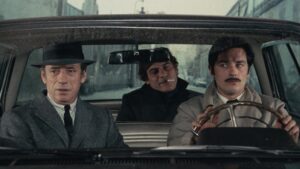
1. The Red Circle (Le cercle rouge), (1970)
Simply one of the coolest movies ever made. Director Melville creates his own universe: the suits and hats are razor-sharp, the décor is chic and monochromatic, and the men are daring but philosophical. It’s a thrilling place to sink into. You couldn’t ask for a better gang of thieves: there’s Delon with a glorious moustache, a manically intense Gian Maria Volonté, and a beautiful, hangdog Yves Montand as an ex-cop battling alcoholism. But Melville doesn’t cheat: André Bourvil’s Inspector Mattei is so upright and professional (and, in a way, charming) that you’re not wholeheartedly rooting for the crooks to get away. Inspired by Rififi, the heist sequence is mostly silent and meticulously constructed; it’s a marvel. The film’s fatalism is both glamorous and oddly moving; the ending that feels inevitable still hits you in your bones.

